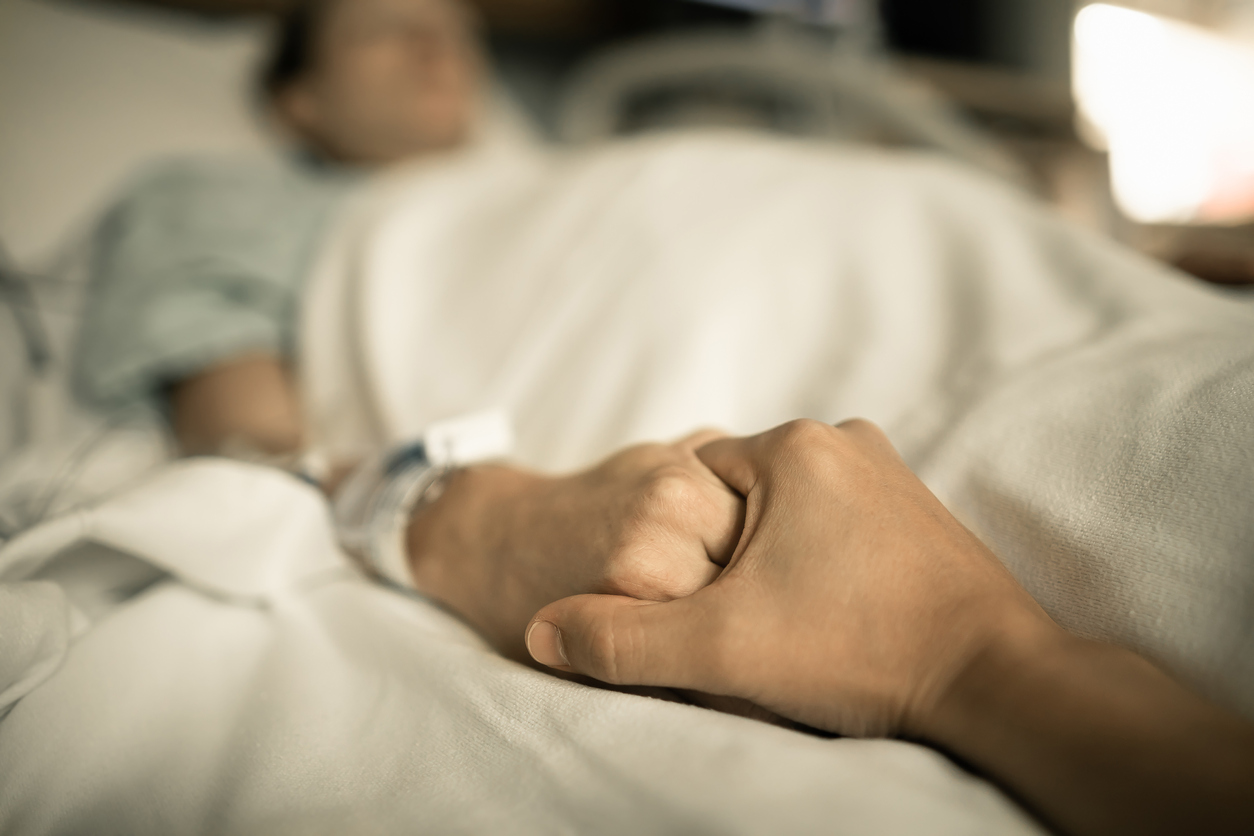

Man holding hand, giving support and comfort to woman, loved one sick in hospital bed.
A new study is changing the world’s perception of what it means to be in a coma. The Scientific American recently came out with an in-depth analysis into the phenomenon known as “convert consciousness,” and found that some people in a come may be conscious and able to hear those around them.
Researchers examined the case of Maria Mazurkevich, a 30-year-old woman who went into a coma after a blood vessel ruptured in her brain. She was placed on a ventilator and became unresponsive, seemingly unaware of her surroundings.
But an EEG scan revealed that her brain was still active.
During the exam, the doctors told her to “keep opening and closing your right hand” and “stop opening and closing your right hand.” She didn’t comply with the doctor’s request, but the scan showed that she was aware of the instructions.
The authors now believe the woman was experiencing “covert consciousness,” which is when the brain reacts to its surroundings with some level of comprehension, but the body remains unresponsive. The study estimates that anywhere between 15% and 20% of coma patients may have some internal awareness of what’s going on around them even if they can’t physically react.
Their findings have major implications for the way the medical community views and treats coma patients. Comatose patients whose covert consciousness is detected early have a better chance of achieving a full recovery, according to the results, which is why the experts believe it’s important to keep studying this phenomenon.
“The standard definition of a comatose patient is someone who is unconscious, is unable to be awakened, and has no signs of awareness or the ability to interact with the environment,” according to the report.
“Patients in a coma caused by severe brain injury may look indistinguishable from someone in a deep sleep, except that most comatose patients cannot breathe on their own and need support from a ventilator, with a tube inserted into their airway.”
But that definition may now be out of date thanks to this latest discovery.
“The problem with severe brain injury,” said neuroscientist Nicholas Schiff, “is that you have people who all look the same who could have very different trajectories of recovery over time, response to treatment, or already achieved level of recovery.”
The researchers also looked at a case from 2006, in which a neuroscientist gave a MRI to a young woman who had suffered a severe brain injury and was believed to be in a vegetative state. The doctor asked the woman to imagine herself playing tennis and walking through her home while administering the exam. The doctor’s instructions activated parts of the woman’s brain similar to those of healthy people.
The first large study of covert consciousness was published in the New England Journal of Medicine in 2019. Doctors asked patients in vegetative states to move their hands while administering an EEG to track their brain activity. A year later, 44% of those who demonstrated some brain activity were no longer vegetative and could live independently.
It’s still not clear what causes covert consciousness, but some studies suggest that it may be caused by brain injuries that disconnect the thalamus from the cerebral cortex, which disrupts the brain’s ability to interpret signals and sensory information. Injuries in multiple parts of the brain may also cause the condition.
It’s also difficult to test patients who appear unresponsive for covert consciousness. People with severe brain injuries often have fluctuating levels of consciousness, which makes it difficult to know whether they are aware of their surroundings. The researchers argue it’s more important to test the patient multiple times with an EEG or MRI, as a single test could be misleading.
Despite these challenges, the phenomenon appears to be so widespread that the issue warrants more investigation.
“This is very big for the field,” Schiff said of the study. “The understanding that, as the brain recovers, one in seven people could be conscious and aware, very much aware, of what’s being said about them, and that this applies every day, in every I.C.U. — it’s gigantic.”
In a shocking incident on December 4, 2024, Brian Thompson, the CEO of UnitedHealthcare, was…
In an unprecedented step toward financial relief and health equity, the city of St. Paul,…
In early November 2024, a shocking tragedy unfolded in Budapest, Hungary, as American nurse Mackenzie…
If Robert F. Kennedy Jr. were to assume leadership of the U.S. Food and Drug…
On November 1, 2024, federal authorities charged 38-year-old Rebecca Fadanelli, owner of Skin Beaute Med…
In a quaint little restaurant in Echo Park, an up and coming author is sitting…